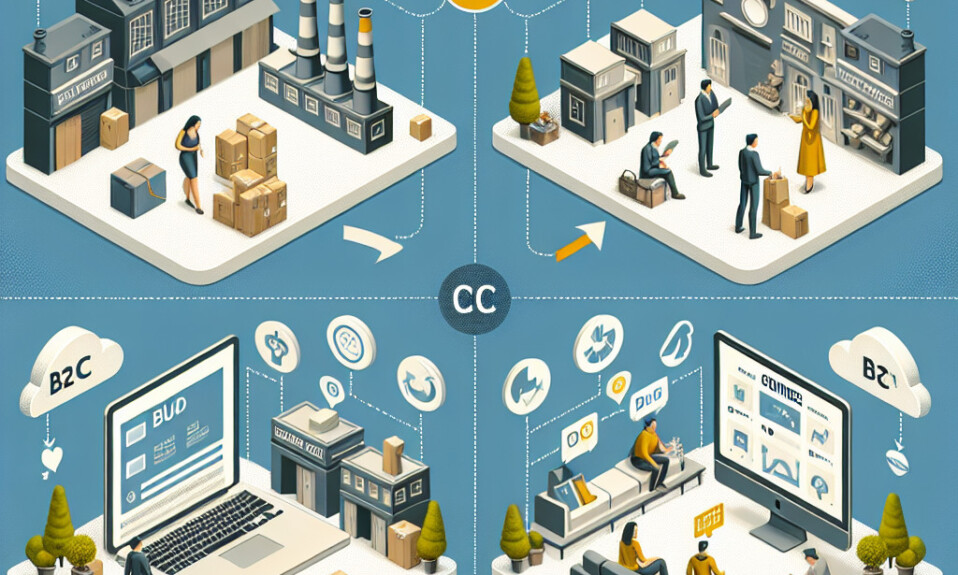- Target audience in B2B vs B2C e-commerce
- Customer behavior in B2B vs B2C e-commerce
- Product offerings in B2B vs B2C e-commerce
- Technology used in B2B vs B2C e-commerce
- Security concerns in B2B vs B2C e-commerce
- Legal considerations in B2B vs B2C e-commerce
- User experience in B2B vs B2C e-commerce
- Product recommendations in B2B vs B2C e-commerce
Target audience in B2B vs B2C e-commerce
B2B E-commerce
B2B e-commerce refers to online transactions between businesses. In this type of e-commerce, the target audience is typically other businesses or professionals who are looking to purchase products or services for their own operations. The key characteristics of the target audience in B2B e-commerce include:
- Decision-makers: The target audience in B2B e-commerce often consists of decision-makers within a company, such as procurement managers or business owners.
- Longer sales cycles: B2B transactions tend to have longer sales cycles compared to B2C transactions, as they often involve larger purchases and more complex decision-making processes.
- Relationship-driven: Building strong relationships with customers is crucial in B2B e-commerce, as trust and credibility play a significant role in the decision-making process.
B2C E-commerce
B2C e-commerce involves online transactions between businesses and individual consumers. The target audience in B2C e-commerce is typically made up of individual shoppers who are looking to purchase products or services for personal use. The key characteristics of the target audience in B2C e-commerce include:
- Impulse buyers: B2C customers are often impulse buyers who make quick purchasing decisions based on emotions or immediate needs.
- Shorter sales cycles: B2C transactions tend to have shorter sales cycles compared to B2B transactions, as they involve smaller purchases and less complex decision-making processes.
- Brand loyalty: Building brand loyalty is essential in B2C e-commerce, as repeat customers are a key driver of sales and revenue.
Overall, while the target audience in B2B and B2C e-commerce may have some similarities, such as the importance of understanding customer needs and preferences, there are also significant differences that need to be taken into account when developing marketing strategies and communication tactics.
Conclusion
Whether you are operating in a B2B or B2C e-commerce market, understanding your target audience is essential for success. By knowing who your customers are, what they want, and how they make purchasing decisions, you can create effective marketing strategies that drive sales and grow your business.
#B2B, #B2C, #e-commerce, #target audience, #marketing strategies, #sales, #decision-making processes, #relationship-driven, #brand loyalty, #impulse buyers
frazy kluczowe:
– Importance of understanding customer needs and preferences
– Building strong relationships with customers
– Repeat customers as a key driver of sales and revenue
Customer behavior in B2B vs B2C e-commerce
B2B E-commerce:
- Longer Sales Cycle: In B2B e-commerce, the sales cycle is typically longer as businesses often require more time to evaluate and make decisions on purchases.
- Relationship-driven: B2B transactions are often based on relationships and trust, with businesses preferring to work with suppliers they have established relationships with.
- Higher Average Order Value: B2B transactions tend to have higher average order values compared to B2C transactions, as businesses often purchase in bulk.
- Multiple Decision Makers: In B2B transactions, there are usually multiple decision makers involved in the purchasing process, which can complicate the decision-making process.
B2C E-commerce:
- Shorter Sales Cycle: B2C e-commerce typically has a shorter sales cycle as consumers make quicker purchasing decisions based on factors like price, convenience, and brand reputation.
- Impulse Purchases: Consumers are more likely to make impulse purchases in B2C e-commerce, especially when presented with limited-time offers or discounts.
- Emotion-driven: B2C transactions are often driven by emotions, with consumers making purchasing decisions based on how a product makes them feel.
- Lower Average Order Value: B2C transactions tend to have lower average order values compared to B2B transactions, as consumers typically purchase smaller quantities.
Overall, understanding the differences in customer behavior between B2B and B2C e-commerce is essential for businesses to tailor their marketing strategies and customer experiences accordingly. By recognizing these distinctions, businesses can better meet the needs and expectations of their target customers, ultimately leading to increased sales and customer satisfaction.
#B2B, #B2C, #e-commerce, #customer behavior, #sales cycle, #average order value, #decision makers, #relationship-driven, #emotion-driven, #impulse purchases, #marketing strategies, #customer satisfaction.
frazy kluczowe:
– Differences in customer behavior in B2B vs B2C e-commerce
– Importance of understanding customer behavior in e-commerce
– Tailoring marketing strategies to customer behavior in e-commerce
– Enhancing customer experiences in B2B and B2C e-commerce.
Product offerings in B2B vs B2C e-commerce
On the other hand, B2C e-commerce involves transactions between a business and individual consumers. In B2C e-commerce, the products that are offered are typically more general and geared towards a mass market audience. These products may include clothing, electronics, household goods, and other consumer products that are purchased for personal use.
One of the key differences between B2B and B2C e-commerce is the level of customization and personalization that is available in the product offerings. In B2B e-commerce, businesses often have the opportunity to work closely with suppliers to customize products to meet their specific needs. This level of customization is not typically available in B2C e-commerce, where products are generally mass-produced and sold to a broad audience.
Another difference between B2B and B2C e-commerce is the pricing structure of the products that are offered. In B2B e-commerce, pricing is often negotiated between the buyer and seller based on factors such as volume discounts, payment terms, and delivery schedules. In contrast, B2C e-commerce typically involves fixed pricing that is set by the seller and is the same for all customers.
In terms of product selection, B2B e-commerce often offers a wider range of products than B2C e-commerce. This is because businesses have specific needs and requirements that may require a diverse range of products to meet. In contrast, B2C e-commerce tends to focus on a narrower range of products that are popular with consumers and have mass market appeal.
Overall, the product offerings in B2B and B2C e-commerce are tailored to the specific needs and preferences of the target audience. Whether it’s specialized products for businesses or mass-market products for consumers, e-commerce platforms strive to provide a diverse range of products to meet the demands of their customers.
#B2B #B2C #e-commerce #product offerings #business transactions #customization #pricing structure #product selection #target audience #consumer products #mass market appeal
frazy kluczowe:
– specialized products for businesses
– mass-market products for consumers
– diverse range of products
– specific needs and preferences
– negotiation of pricing
– volume discounts and payment terms
– customization and personalization
– fixed pricing structure
– product selection and availability
– target audience and market segmentation
Technology used in B2B vs B2C e-commerce
1. Website design and functionality
– B2B e-commerce websites are typically more complex and feature-rich than B2C websites. They often include advanced search capabilities, personalized pricing, and account management tools.
– B2C e-commerce websites, on the other hand, focus more on user experience and visual appeal. They may include features like product recommendations, customer reviews, and social sharing buttons.
2. Payment processing
– B2B e-commerce transactions are usually larger and more complex than B2C transactions. As a result, B2B e-commerce platforms often support multiple payment methods, including invoicing and purchase orders.
– B2C e-commerce platforms, on the other hand, prioritize convenience and speed. They typically offer a variety of payment options, including credit cards, digital wallets, and buy now, pay later services.
3. Customer relationship management (CRM)
– B2B e-commerce platforms often integrate with CRM systems to track and manage customer interactions. This allows businesses to personalize their marketing efforts and provide better customer service.
– B2C e-commerce platforms may also use CRM systems, but the focus is more on analyzing customer behavior and optimizing the shopping experience.
4. Inventory management
– B2B e-commerce platforms need robust inventory management systems to handle large quantities of products and complex supply chains. They may also integrate with ERP systems for seamless order processing.
– B2C e-commerce platforms typically have simpler inventory management needs, but still require real-time updates to prevent stockouts and backorders.
5. Security and compliance
– Both B2B and B2C e-commerce platforms must adhere to strict security standards to protect customer data and prevent fraud. This includes using SSL encryption, PCI compliance, and secure payment gateways.
– B2B e-commerce platforms may also need to comply with industry-specific regulations, such as HIPAA for healthcare or GDPR for data privacy.
In conclusion, while B2B and B2C e-commerce share many of the same technologies, the way they are implemented and utilized can vary significantly. Businesses must carefully consider their unique needs and requirements when choosing an e-commerce platform.
#B2B #B2C #e-commerce #technology #website #payment #CRM #inventory #security
frazy kluczowe:
– Technology used in B2B e-commerce
– Technology used in B2C e-commerce
– Differences in B2B vs B2C e-commerce technology
– E-commerce technology trends in B2B and B2C industries
Security concerns in B2B vs B2C e-commerce
B2B e-commerce security concerns
In B2B e-commerce, businesses are dealing with other businesses, which means that the transactions are typically larger in scale and involve sensitive information. Some of the key security concerns in B2B e-commerce include:
| Security Concern | Description |
|---|---|
| Data breaches | Businesses need to protect their sensitive data, such as financial information and trade secrets, from cyber attacks and data breaches. |
| Authentication | Ensuring that only authorized personnel have access to the B2B e-commerce platform and that transactions are secure. |
| Supply chain security | Verifying the security of the entire supply chain to prevent any vulnerabilities that could be exploited by cyber criminals. |
B2C e-commerce security concerns
In B2C e-commerce, businesses are dealing directly with consumers, which means that the transactions are typically smaller in scale but involve a larger volume of transactions. Some of the key security concerns in B2C e-commerce include:
| Security Concern | Description |
|---|---|
| Payment security | Ensuring that customers’ payment information is secure and protected from fraud and unauthorized access. |
| Phishing attacks | Protecting customers from phishing attacks that attempt to steal their personal information or login credentials. |
| Privacy concerns | Respecting customers’ privacy and ensuring that their personal information is not misused or shared without their consent. |
Comparison of security concerns
While both B2B and B2C e-commerce face similar security concerns, such as data breaches and authentication, the scale and complexity of these concerns differ. B2B e-commerce often involves larger transactions and more sensitive information, requiring a higher level of security measures. On the other hand, B2C e-commerce deals with a larger volume of transactions and a wider range of customers, making payment security and privacy concerns more critical.
Overall, businesses operating in both B2B and B2C e-commerce must prioritize security to protect their customers and their own sensitive information from cyber threats.
#B2B, B2C, e-commerce, security concerns, data breaches, authentication, supply chain security, payment security, phishing attacks, privacy concerns
frazy kluczowe: business-to-business e-commerce, business-to-consumer e-commerce, cyber attacks, data breaches, supply chain security, payment information, phishing attacks, personal information, login credentials, privacy concerns, security measures, cyber threats.
Legal considerations in B2B vs B2C e-commerce
Key legal considerations in B2B e-commerce:
1. Contractual agreements: B2B transactions often involve more complex contractual agreements than B2C transactions. Businesses need to ensure that their contracts are legally binding and enforceable.
2. Data protection: B2B transactions may involve the exchange of sensitive business information, so businesses need to comply with data protection laws to ensure the security and privacy of this information.
3. Intellectual property rights: B2B transactions may involve the use of intellectual property, so businesses need to ensure that they have the necessary rights to use and protect this property.
4. Dispute resolution: B2B transactions may result in disputes between businesses, so businesses need to have mechanisms in place for resolving these disputes, such as arbitration or mediation.
Key legal considerations in B2C e-commerce:
1. Consumer protection: B2C transactions are subject to consumer protection laws, which are designed to protect consumers from unfair or deceptive practices. Businesses need to comply with these laws to avoid legal consequences.
2. Payment processing: B2C transactions involve the processing of payments from consumers, so businesses need to ensure that their payment processing systems are secure and compliant with payment card industry standards.
3. Product liability: B2C transactions involve the sale of products to consumers, so businesses need to ensure that their products are safe and comply with product liability laws to avoid legal liability.
4. Advertising and marketing: B2C transactions involve the advertising and marketing of products to consumers, so businesses need to ensure that their advertising and marketing practices comply with laws and regulations, such as truth in advertising laws.
Hashtags: #B2B #B2C #ecommerce #legalconsiderations
Keywords: legal considerations, B2B e-commerce, B2C e-commerce, contractual agreements, data protection, intellectual property rights, dispute resolution, consumer protection, payment processing, product liability, advertising, marketing
Long-tail phrases: , key legal considerations in B2B e-commerce, key legal considerations in B2C e-commerce, consumer protection laws in B2C e-commerce, product liability laws in B2C e-commerce.
User experience in B2B vs B2C e-commerce
B2B E-commerce
In B2B e-commerce, the user experience is typically more complex and focused on efficiency and functionality rather than aesthetics. B2B buyers are often looking to make large purchases, so the platform needs to be able to handle bulk orders and provide detailed product information. The user interface should be intuitive and easy to navigate, with features such as quick order forms, account management tools, and personalized pricing options.
One of the key differences in B2B e-commerce is the need for a seamless integration with existing business systems, such as inventory management and accounting software. This requires a high level of customization and integration capabilities, as well as robust security measures to protect sensitive business data.
B2C E-commerce
On the other hand, B2C e-commerce platforms are typically more focused on creating an engaging and visually appealing user experience. B2C buyers are often looking for a seamless shopping experience that is both convenient and enjoyable. This means that the platform should be optimized for mobile devices, with fast loading times and easy navigation.
Personalization is also key in B2C e-commerce, with features such as product recommendations, personalized offers, and targeted marketing campaigns. The checkout process should be streamlined and user-friendly, with multiple payment options and a secure payment gateway to instill trust in the buyer.
Key Differences
While there are similarities in the user experience requirements for B2B and B2C e-commerce, there are also key differences that need to be taken into account. B2B platforms need to focus on efficiency, functionality, and integration with existing systems, while B2C platforms need to prioritize aesthetics, engagement, and personalization.
Ultimately, the success of an e-commerce platform, whether B2B or B2C, hinges on the user experience. By understanding the unique needs and preferences of their target audience, businesses can create a user-friendly and engaging platform that drives sales and builds customer loyalty.
- Key Takeaways:
- B2B e-commerce focuses on efficiency and functionality
- B2C e-commerce prioritizes aesthetics and engagement
- Personalization is key in both B2B and B2C e-commerce
- Understanding the unique needs of the target audience is crucial for success
#UserExperience #B2B #B2C #Ecommerce #Personalization #Integration #Efficiency
frazy kluczowe:
– Importance of user experience in B2B and B2C e-commerce
– Key differences in UX between B2B and B2C platforms
– Personalization and efficiency in e-commerce
– Creating a seamless shopping experience for B2B and B2C buyers
Product recommendations in B2B vs B2C e-commerce
B2B e-commerce
In B2B e-commerce, product recommendations are typically based on the specific needs and preferences of the business customer. These recommendations are often personalized to reflect the unique requirements of the customer’s industry, size, and purchasing history. B2B e-commerce platforms may also use data analytics and machine learning algorithms to suggest products that are likely to be of interest to the customer based on their past purchases and browsing behavior.
One key difference between B2B and B2C e-commerce is the importance of building long-term relationships with customers in the B2B sector. Product recommendations in B2B e-commerce are not just about driving immediate sales, but also about fostering trust and loyalty over time. This means that product recommendations in B2B e-commerce are often more focused on providing value-added solutions that address the customer’s specific business challenges.
B2C e-commerce
In contrast, product recommendations in B2C e-commerce are typically more focused on driving impulse purchases and increasing average order value. B2C e-commerce platforms often use techniques such as cross-selling and upselling to suggest related products or higher-priced alternatives to customers. These recommendations are often based on factors such as popular trends, customer reviews, and social proof.
Another key difference between B2B and B2C e-commerce is the volume of transactions and the size of the average order. B2C e-commerce platforms may have a larger customer base and a higher frequency of purchases, which means that product recommendations need to be more scalable and automated. B2C e-commerce platforms may also use techniques such as collaborative filtering and content-based filtering to generate product recommendations based on the behavior of similar customers.
Conclusion
In conclusion, product recommendations play a critical role in both B2B and B2C e-commerce, but the approach to product recommendations can vary significantly between these two types of e-commerce. Businesses operating in the B2B sector should focus on providing personalized, value-added solutions that build long-term relationships with customers, while businesses in the B2C sector should focus on driving impulse purchases and increasing average order value. By understanding the differences between B2B and B2C e-commerce, businesses can tailor their product recommendation strategies to better meet the needs of their customers and drive sales.
#B2B #B2C #e-commerce #product recommendations #personalization #customer loyalty #data analytics #machine learning #cross-selling #upselling #collaborative filtering #content-based filtering
frazy kluczowe:
– personalized product recommendations for B2B customers
– driving impulse purchases in B2C e-commerce
– building long-term relationships with B2B customers
– increasing average order value in B2C e-commerce
– data analytics and machine learning in product recommendations
- The safety considerations of laser cleaning - 13 May 2024
- The difference between B2B and B2C e-commerce - 13 May 2024
- Fixed price or time and materials – what to choose? - 2 March 2024








